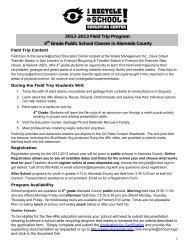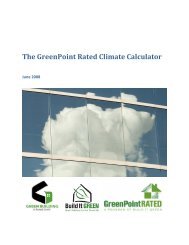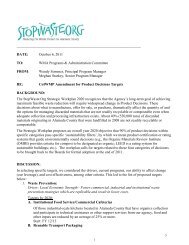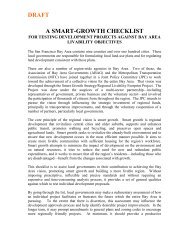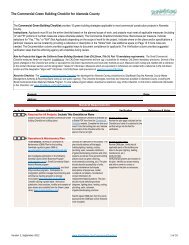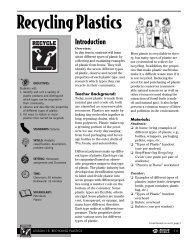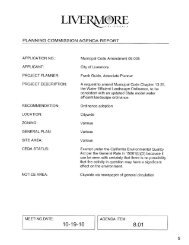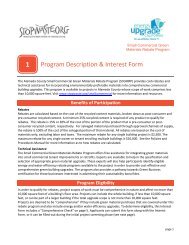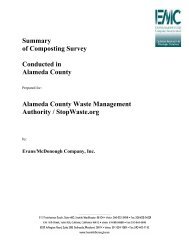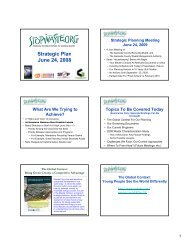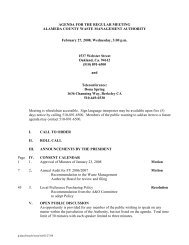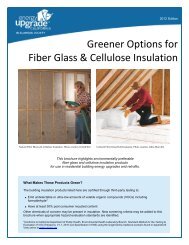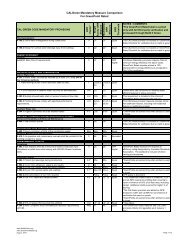Bay-Friendly Landscaping Principles and Practices - StopWaste.org
Bay-Friendly Landscaping Principles and Practices - StopWaste.org
Bay-Friendly Landscaping Principles and Practices - StopWaste.org
Create successful ePaper yourself
Turn your PDF publications into a flip-book with our unique Google optimized e-Paper software.
Integrated Pest Management (IPM) is a holistic approach to controlling insects, plant<br />
diseases, weeds, <strong>and</strong> other pests. IPM programs integrate the use of many environmentally-sound strategies for<br />
managing, but not necessarily eliminating, pests. First <strong>and</strong> foremost, IPM seeks to prevent pests by fostering a<br />
healthy environment in which plants have the strength to resist disease <strong>and</strong> insect infestations <strong>and</strong> to out-compete<br />
weeds. An IPM approach requires an underst<strong>and</strong>ing of the life cycles of pests <strong>and</strong> beneficial <strong>org</strong>anisms <strong>and</strong><br />
regular monitoring of their populations. If a pest problem is identified, IPM then considers all viable solutions <strong>and</strong><br />
uses a variety of techniques to control pests, rather than turning only to pesticides. The least toxic pesticides are<br />
used as a last resort only. IPM offers a great opportunity to market your skills to your clients by providing the following<br />
services:<br />
1. Use Integrated Pest Management<br />
<strong>Principles</strong><br />
& <strong>Practices</strong><br />
A. Prevent pest problems<br />
Description<br />
Applying the best l<strong>and</strong>scape design,<br />
construction <strong>and</strong> management practices<br />
to prevent pests is always preferable to<br />
trying to control them after they become<br />
established.<br />
Applications<br />
Design to prevent pests by:<br />
n Choosing a diversity of species that are<br />
well suited to the site.<br />
n Selecting resistant varieties <strong>and</strong> local<br />
native species, including species that<br />
attract beneficial insects.<br />
n Placing plants at proper distances<br />
from buildings, giving them space for<br />
adequate air circulation <strong>and</strong> room to<br />
reach their natural size <strong>and</strong> shape.<br />
n Avoiding over-planting for instant<br />
color.<br />
n Including compost in the soil<br />
specifications<br />
Prevent pests during l<strong>and</strong>scape<br />
construction <strong>and</strong> maintenance by:<br />
n Selecting plant material that is free<br />
from disease <strong>and</strong> insects.<br />
n Planting at the right depth.<br />
n Watering thoroughly but not overwatering.<br />
n Sheetmulch, see page 31.<br />
n Keeping mulch on the surface of the<br />
soil at all times.<br />
n Using slow release fertilizers if soil tests<br />
indicate their need, <strong>and</strong> not overfertilizing.<br />
n Pruning judiciously — severe pruning<br />
stimulates new growth, stresses plants<br />
<strong>and</strong> encourages pests <strong>and</strong> disease.<br />
n Eliminating noxious weeds before they<br />
go to seed or spread uncontrollably.<br />
n Cleaning equipment after use.<br />
n Inspecting <strong>and</strong> removing invasive plant<br />
parts or seeds from your clothing,<br />
tools <strong>and</strong> vehicle before leaving an<br />
infested site.<br />
n Cleaning up wood, fruit <strong>and</strong> other<br />
plant material that is infected with<br />
disease — compost the debris only<br />
if you have the experience to get the<br />
compost pile to temperatures over<br />
135 o F for an extended period.<br />
IPM for Weed Control<br />
Prevent weeds first:<br />
n Purchase only weed free plants <strong>and</strong> compost<br />
n Use drip irrigation to apply water only to desired plants<br />
n Use mulch to suppress weeds. Sheet mulching is an effective strategy that<br />
layers cardboard, compost <strong>and</strong> then coarse mulch (see page 31).<br />
Monitor weeds:<br />
n Create a map that locates the species <strong>and</strong> density of weeds<br />
Benefits<br />
A healthy, diverse l<strong>and</strong>scape that<br />
prevents pests in the first place is critical<br />
to eliminating the need for pesticides,<br />
thereby reducing pollution <strong>and</strong> protecting<br />
the health of the San Francisco <strong>Bay</strong>.<br />
Try cultural, mechanical & physical controls before reaching<br />
for the herbicides:<br />
n Flame weeders use a targeted flame to kill weeds <strong>and</strong> are very effective for<br />
controlling weeds in sidewalks <strong>and</strong> other hardscapes.<br />
n Boiling water, hot foam <strong>and</strong> high pressure steam both work to kill weeds <strong>and</strong><br />
are a better option in areas where an open flame may be hazardous.<br />
Select herbicides as a last resort & use the least toxic:<br />
n Corn gluten meal is a pre-emergent herbicide that also acts as a fertilizer.<br />
The timing of the application is important, if it is used after weeds have started<br />
growing, they will actually benefit from its fertilizing properties.<br />
n Horticultural vinegar, or acetic acid, is also effective at killing certain weeds. Use<br />
with caution since acetic acid greater than 5% can cause skin irritation or eye<br />
damage.<br />
n Herbicidal soaps are highly refined soaps that can penetrate the waxy coating<br />
on plant leaves, causing them to dry out. Some of these products also contain<br />
essential oils that enhance their herbicidal properties.<br />
Adapted from Quarles, William, Say Good-bye to Weed Worries, Fine Gardening, 80, pp. 48-51 <strong>and</strong><br />
Beyond Pesticides Fact Sheet: Least Toxic Control of Weeds.<br />
42<br />
3



